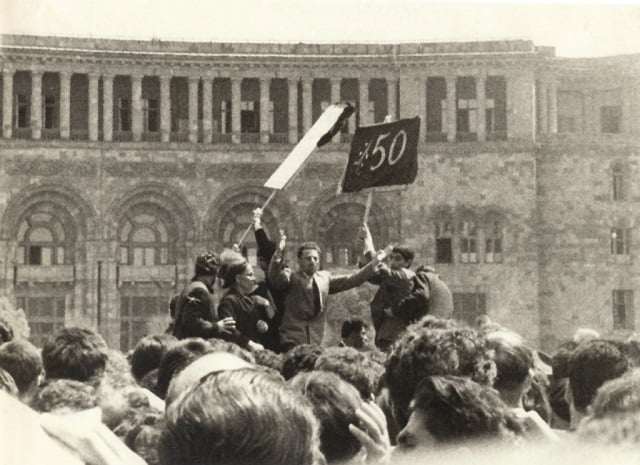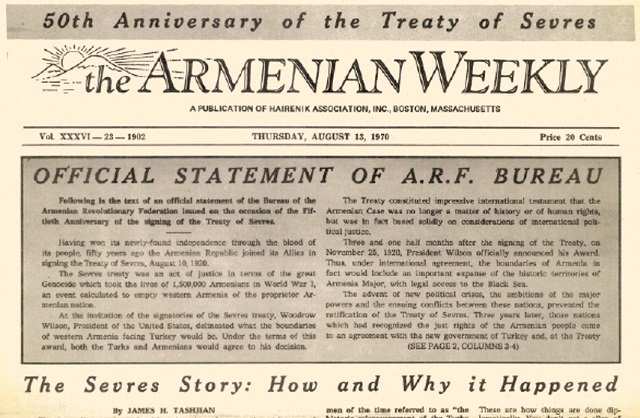The Armenian Weekly. It is hard to believe, but 55 years have passed since the 50th commemoration of the Armenian Genocide – half a century, plus half a decade. From the genocidal policies set by the Young Turks, Kemal Ataturk and all governments following Kemalist precepts, to the present neo-Ottoman, semi-theocratic regime headed by Islamist Erdogan and his cohorts, the same criminal policies continue to be implemented. They thumb their noses at the Lausanne Treaty, by omission and commission, in the deafening silence of the signatories of that misbegotten Treaty, that relegated the Sèvres Treaty to silent oblivion…not final demise.
Looking back, we can’t help but notice that a lot has changed over the 100 years since the signing of the Sèvres Treaty. If that document had been acted upon at that crucial point in history, the desperate policies of the moribund empires, including their Lausanne Treaty, would have never happened, sparing the hapless peoples of Asia Minor, Southern Caucasus and the Middle East the anguish in which they find themselves trapped today.
Since those devastating days that set the stage for the present unresolved dilemma of continuing genocidal policies threatening minorities in the region, it is the 105th time that we Armenians, all over the world, gathered together in church halls or community centers, made speeches and prayed for the souls of our one and a half million martyrs. After doing some “political” work, including securing proclamations from mayors and governors, trying to get officials to make statements without diluting the veracity of the Genocide, without lowering it to the level of “regrettable incidents that took place more than 90 years ago,” we returned to our homes.
Read also
We ask ourselves, why did it take more than a century to establish the veracity of the first Genocide of the 20th century and do justice to the one and a half million victims and their descendants? Perhaps a revision of the events following the Armistice of 1918 that put an end to World War I would shed light on what transpired.
The Czarist, British, French, Dutch and Belgian Empires were all gone, with their constituent nations achieving independence. From those troubled times of imperialism, colonialism and racist oppression and exploitation, only one disturbing anomaly survives and presently thrives as a menacing resurgence of neo-Ottoman ambitions, shielded by its gradually unraveling NATO membership and a veiled alliance with an ISIS-type Islamist upsurge. The name of that anomaly is the ‘Republic of Turkey’ with the credentials of a ‘nation state.’ With the connivance of both Western and Eastern major powers, an entire sub-continent, Asia Minor – some three-quarters of the defunct Ottoman Empire’s territory with a population of mostly non-Turkish minorities – ended up within the semi-imperial boundaries of this ‘national’ Republic of Turkey.
Today, 105 years after the Medz Yeghern, for a second time Armenia finds herself recognized as an independent, sovereign state, facing an unstable world given to swift and violent changes. A lot has developed since 1915. A lot has changed, but no matter how many socio-political changes take place in the countries surrounding Armenia, the basic nature of their ethnic, religious and cultural identity tends to resist any permanent alteration.
Thus, Armenia remains a remote boundary, a disconnected bastion of the Christian Northwest, facing an emerging Islamic Southeast. Accepting this fact, we come face to face with the most powerful of our neighbors, the present Islamic/Kemalist Turkey. Some remarks are necessary in order to grasp the sources of the trauma that plague Armeno-Turkish relations.
Over seven centuries ago, abandoning their Asiatic homeland, the Ottoman Turks moved West, gradually conquering an ailing Byzantine Empire, as well as extensive territories in Eastern Europe. The Ottoman Sultan’s dream was to establish a Turkish version of the defunct Byzantine Empire, this time under the crescent moon of Sunni Islam. After reaching as far as the gates of Vienna, finally defeated and rejected by Christian Europe, the Ottomans settled down in their new Anatolian ‘homeland’ and busied themselves managing—or mismanaging, if you prefer—a vast empire that included most of Asia Minor and its diverse populations: Armenians, Kurds, Alevis, Greeks, Assyrians and almost the entire Arab world.
Stumbling into World War I, the Ottoman Empire was encouraged by its petroleum-starved German and Austrian allies to look East, in order to reach the oil fields of Baku defended mainly by the Armenian volunteer forces of the Armenian Revolutionary Federation (ARF) and beyond, where Turkish-speaking Islamic peoples lived under Russian hegemony.
In spite of the fact that the Empire finally fell apart with the defeat of the Central Powers, Ataturk managed to salvage a new, chauvinistically Turkish, western-type republic, with a new, Latinized alphabet, European clothing, etc., retaining, however, the Ittihadist dreams of a Turanian Empire. In this context, it would be hard to find a difference between the Pan-Turanian precepts of the Ittihadist leadership of 1915 and those of the present-day Kemalist/Islamic establishment. The only difference is the altered geopolitical reality within which the Turkish political mind must now maneuver.
One must bear in mind that the Turkish nation-state is only around 10 decades old. Ataturk, in order to change the Ottoman Sultan’s submissive subjects into self-respecting Turkish citizens, brainwashed them into believing that they were the sons and daughters of a modern European country. At the same time— in order to subdue the Turks’ Islamic fervor—he encouraged the racist mythology of past Turanian glory enhanced by early Islamic conquests.
Today, as a retrograde Turkish regime continues its aggressive efforts to rebuild its past Ottoman hegemony, and in view of all the ongoing armed conflicts and the ominous bearing they have on the destinies of the nations in Asia Minor and Transcaucasia – all affected by the abandonment of the Sèvres Treaty – we can’t deny the fact that the Republic of Armenia, in its present state blockaded and landlocked may face a troubled future. In this fast-changing scenario, what should Armenia’s policies be vis a vis its neighbors and the world-at-large?
To start with, as long as Turkey refuses to come out of its obsolete and discredited mind-set, it will be next to impossible for Armenia to come to terms with Ankara. We must bear in mind that Turkey’s other neighbors are not exactly thrilled with many of Ankara’s regional policies either. Iran, Iraq, Syria, Israel, Greece, Cyprus, Libya and Egypt all have legitimate reasons for concern.
Armenia is not alone facing this problem; therefore, Yerevan is in a position to form alliances with many of these countries whose national interests coincide with our own on several issues. We must also bear in mind that the Islamic world is not a monolith. Past and present conflicts testify to that, and national interests and state priorities will always supersede sectarian ties. Proof of this reality is the example of the Kurdish national liberation movement against no less than three Islamic countries.
The Caucasus, despite recent upheavals, will have to cater to Russian interests. An openly anti-Russian stance on the part of Caucasian republics would invite nothing but trouble. One simply cannot ignore the immense territorial, industrial and cultural presence of the Russian Federation spilling into the Caucasus.
In any future ideological/religious confrontations between the Christian/European Northwest and mostly Islamic Southeast, the global concern will be the avoidance of a devastating clash between the two. All major powers on both sides, even as they maneuver to get the upper hand in this competition, agree that such a conflagration must be avoided at all costs. In this context, the geographic location and cultural heritage of Armenia dictate a policy of mediation, a policy of defusing possible conflicts before they reach critical mass, threatening the very survival of a tolerant, civilized and enlightened humanity.
Armenia can be the cultural, political, economic conduit and mediator between North and South, East and West. Armenia can do this and promote its own cause at the same time. Essentially, the Armenian Cause is a case of recognizing the truth and doing justice. These prerequisites are not narrow partisan acts; on the contrary, they are universally recognized and accepted norms that make peaceful human progress possible for generations to come.
One cannot help but remember the spirit of unity that 55 years ago brought all Armenians together, from Yerevan to the most remote corners of the Diaspora, to bear witness to one of the most horrendous crimes committed against humanity on its 50th anniversary. On that occasion, we proved to the world that we are capable of thinking, planning and doing productive work as one nation in harmony with our common history and destiny.
That same spirit is needed today more than ever, as our nation, with renewed hope, awaits the total recognition and restitution of its national rights, as formally ratified by the Treaty of Sèvres, wherein lies the assurance of peace and prosperity of an entire region presently in the throes of endless conflict.
Tatul Sonentz-Papazian
Main caption: A scene from the massive demonstration at Yerevan’s Lenin Square on April 24, 1965 (Photo: Armenian Genocide Memorial Institute)























































